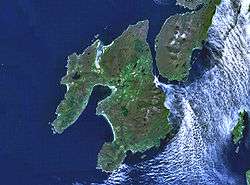Colonsay Group
The Colonsay Group is an estimated 5,000 m thick sequence of mildly metamorphosed Neoproterozoic sedimentary rocks that outcrop on the islands of Colonsay, Islay and Oronsay and the surrounding seabed. They have been correlated with the Grampian Group, the oldest part of the Dalradian Supergroup.
| Colonsay Group Stratigraphic range: Neoproterozoic | |
|---|---|
 Smaull Greywacke Formation, near Rubha Lamanais, Rinns of Islay | |
| Type | Group |
| Lithology | |
| Primary | Sandstone |
| Other | Shale, siltstone |
| Location | |
| Region | Inner Hebrides |
| Type section | |
| Named for | Colonsay |


Stratigraphy
The sequences on Islay and Colonsay/Oronsay are not identical and correlation between them is uncertain. Both sequences are divided up into a series of formations. The Islay sequence lies unconformably on gneisses of the Rhinns complex and is thought to be mostly older than the Colonsay/Oronsay sequence. A possible correlation has been made between sandstones of the Oronsay formation which form the base of the preserved sequence on Colonsay/Oronsay and those of the Smaull and Sanaig Greywacke formations towards the top of the Islay sequence.[1] Within Colonsay, the following sequence is recognised (in stratigraphical order with topmost/youngest first):[2]
- Staosnaig Phyllite Formation
- Kiloran Flags Formation
- Milbuie Arkose Formation
- Kilchattan Formation
- Machrins Arkose Formation
- Dun Gallain Grit Formation
- Oronsay Greywacke Formation
Age
The upper bound to the age of the sequence is given by the presence of detrital titanite grains that give an age of about 942 Ma and detrital zircon grains giving an age of about 1025 Ma, suggesting that the Colonsay Group is Neoproterozoic. The minimum age is given by dating of an intrusion that cuts the sequence at Kiloran Bay, which is dated to about 440 Ma (Early Silurian).[1]
Correlation
The Colonsay Group has at various times been correlated with the Torridonian, the Moine Supergroup and the Appin Group and Grampian Group of the lower Dalradian Supergroup. Analysis of the provenance area for the Colonsay Group compared to these other sequences, suggests that the best match in terms of provenance is with the Grampian Group, the lowermost part of the Dalradian sequence.[1] The relationship of the Colonsay Group to the Bowmore Sandstone Group, with which they are in tectonic contact across the Loch Gruinart fault, is uncertain, although both have been correlated with the Grampian Group.
References
- McAteer, C.A.; Daly J.; Flowerdew M.J.; Connelly J.N.; Housh T.B.; Whitehouse M.J. (2010). "Detrital zircon, detrital titanite and igneous clast U-Pb geochronology and basement-cover relationships of the Colonsay Group, SW Scotland: Laurentian provenance and correlation with the Neoproterozoic Dalradian Supergroup". Precambrian Research. Elsevier. 181 (1–4): 21–42. doi:10.1016/j.precamres.2010.05.013. Retrieved 16 September 2012.
- British Geological Survey 1:50,000 scale provisional geological map sheet (Scotland) 35 Colonsay 1996
